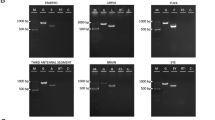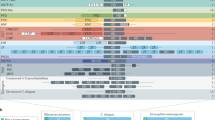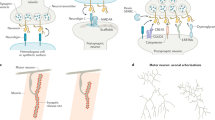Abstract
Neurons are thought to use diverse families of cell-surface molecules for cell recognition during circuit assembly. In Drosophila, alternative splicing of the Down syndrome cell adhesion molecule (Dscam) gene potentially generates 38,016 closely related transmembrane proteins of the immunoglobulin superfamily, each comprising one of 19,008 alternative ectodomains linked to one of two alternative transmembrane segments1. These ectodomains show isoform-specific homophilic binding, leading to speculation that Dscam proteins mediate cell recognition2. Genetic studies have established that Dscam is required for neural circuit assembly1,3,4,5,6,7,8,9,10, but the extent to which isoform diversity contributes to this process is not known. Here we provide conclusive evidence that Dscam diversity is essential for circuit assembly. Using homologous recombination, we reduced the entire repertoire of Dscam ectodomains to just a single isoform. Neural circuits in these mutants are severely disorganized. Furthermore, we show that it is crucial for neighbouring neurons to express distinct isoforms, but that the specific identity of the isoforms expressed in an individual neuron is unimportant. We conclude that Dscam diversity provides each neuron with a unique identity by which it can distinguish its own processes from those of other neurons, and that this self-recognition is essential for wiring the Drosophila brain.
This is a preview of subscription content, access via your institution
Access options
Subscribe to this journal
Receive 51 print issues and online access
$199.00 per year
only $3.90 per issue
Buy this article
- Purchase on Springer Link
- Instant access to full article PDF
Prices may be subject to local taxes which are calculated during checkout




Similar content being viewed by others
References
Schmucker, D. et al. Drosophila Dscam is an axon guidance receptor exhibiting extraordinary molecular diversity. Cell 101, 671–684 (2000)
Wojtowicz, W. M., Flanagan, J. J., Millard, S. S., Zipursky, S. L. & Clemens, J. C. Alternative splicing of Drosophila Dscam generates axon guidance receptors that exhibit isoform-specific homophilic binding. Cell 118, 619–633 (2004)
Wang, J., Zugates, C. T., Liang, I. H., Lee, C. H. & Lee, T. Drosophila Dscam is required for divergent segregation of sister branches and suppresses ectopic bifurcation of axons. Neuron 33, 559–571 (2002)
Zhu, H. et al. Dendritic patterning by Dscam and synaptic partner matching in the Drosophila antennal lobe. Nature Neurosci. 9, 349–355 (2006)
Chen, B. E. et al. The molecular diversity of Dscam is functionally required for neuronal wiring specificity in Drosophila. Cell 125, 607–620 (2006)
Hummel, T. et al. Axonal targeting of olfactory receptor neurons in Drosophila is controlled by Dscam. Neuron 37, 221–231 (2003)
Zhan, X. L. et al. Analysis of Dscam diversity in regulating axon guidance in Drosophila mushroom bodies. Neuron 43, 673–686 (2004)
Matthews, B. J. et al. Dendrite self-avoidance is controlled by Dscam. Cell 129, 593–604 (2007)
Hughes, M. E. et al. Homophilic Dscam interactions control complex dendrite morphogenesis. Neuron 54, 417–427 (2007)
Soba, P. et al. Drosophila sensory neurons require Dscam for dendritic self-avoidance and proper dendritic field organization. Neuron 54, 403–416 (2007)
Sperry, R. W. Chemoaffinity in the orderly growth of nerve fiber patterns and connections. Proc. Natl Acad. Sci. USA 50, 703–710 (1963)
Missler, M. & Südhof, T. C. Neurexins: three genes and 1001 products. Trends Genet. 14, 20–26 (1998)
Takeichi, M. et al. Cadherins in brain patterning and neural network formation. Cold Spring Harb. Symp. Quant. Biol. 62, 505–510 (1997)
Kohmura, N. et al. Diversity revealed by a novel family of cadherins expressed in neurons at a synaptic complex. Neuron 20, 1137–1151 (1998)
Graveley, B. R. et al. The organization and evolution of the dipteran and hymenopteran Down syndrome cell adhesion molecule (Dscam) genes. RNA 10, 1499–1506 (2004)
Wang, J. et al. Transmembrane/juxtamembrane domain-dependent Dscam distribution and function during mushroom body neuronal morphogenesis. Neuron 43, 663–672 (2004)
Neves, G., Zucker, J., Daly, M. & Chess, A. Stochastic yet biased expression of multiple Dscam splice variants by individual cells. Nature Genet. 36, 240–246 (2004)
Nern, A. et al. An isoform-specific allele of Drosophila N-cadherin disrupts a late step of R7 targeting. Proc. Natl Acad. Sci. USA 102, 12944–12949 (2005)
Wojtowicz, W. M. et al. A vast repertoire of Dscam binding specificities arises from modular interactions of variable Ig domains. Cell (in the press)
Jefferis, G. S. & Hummel, T. Wiring specificity in the olfactory system. Semin. Cell Dev. Biol. 17, 50–65 (2006)
Zipursky, S. L., Wojtowicz, W. M. & Hattori, D. Got diversity? Wiring the fly brain with Dscam. Trends Biochem. Sci. 31, 581–588 (2006)
Kramer, A. P. & Kuwada, J. Y. Formation of the receptive fields of leech mechanosensory neurons during embryonic development. J. Neurosci. 3, 2474–2486 (1983)
Grueber, W. B., Ye, B., Moore, A. W., Jan, L. Y. & Jan, Y. N. Dendrites of distinct classes of Drosophila sensory neurons show different capacities for homotypic repulsion. Curr. Biol. 13, 618–626 (2003)
Lee, T. & Luo, L. Mosaic analysis with a repressible cell marker for studies of gene function in neuronal morphogenesis. Neuron 22, 451–461 (1999)
Rong, Y. S. & Golic, K. G. Gene targeting by homologous recombination in Drosophila. Science 288, 2013–2018 (2000)
Adams, M. D. et al. The genome sequence of Drosophila melanogaster. Science 287, 2185–2195 (2000)
Newsome, T. P., Asling, B. & Dickson, B. J. Analysis of Drosophila photoreceptor axon guidance in eye-specific mosaics. Development 127, 851–860 (2000)
Stortkuhl, K. F., Hofbauer, A., Keller, V., Gendre, N. & Stocker, R. F. Analysis of immunocytochemical staining patterns in the antennal system of Drosophila melanogaster. Cell Tissue Res. 275, 27–38 (1994)
Acknowledgements
We thank members of the Zipursky and Dickson laboratories for critical comments on the manuscript. This work was supported by grants from the Austrian Science Fund (B.J.D) and NIH (S.L.Z.). Work at the Institute of Molecular Pathology is also supported by funds from Boehringer Ingelheim GmbH. S.L.Z. is an Investigator of the Howard Hughes Medical Institute.
Author Contributions B.J.D. designed the targeting strategy, and E.D., E.V. and B.J.D. generated the Dscamsingle alleles, which were verified by E.D., D.H. and H.W.K. All biochemical and phenotypic analyses were performed by D.H., together with H.W.K. The intragenic MARCM strategy was conceived by D.H., E.D., H.W.K. and S.L.Z. B.J.D., D.H. and S.L.Z. wrote the manuscript.
Author information
Authors and Affiliations
Corresponding authors
Ethics declarations
Competing interests
Reprints and permissions information is available at www.nature.com/reprints. The authors declare no competing financial interests.
Supplementary information
Supplementary Figure
The file contains Supplementary Figure S1 which outlines the strategy used to isolate Dscamsingle and DscamFRT alleles. (PDF 174 kb)
Rights and permissions
About this article
Cite this article
Hattori, D., Demir, E., Kim, H. et al. Dscam diversity is essential for neuronal wiring and self-recognition. Nature 449, 223–227 (2007). https://doi.org/10.1038/nature06099
Received:
Accepted:
Published:
Issue Date:
DOI: https://doi.org/10.1038/nature06099
This article is cited by
-
Division of developmental phases of freshwater leech Whitmania pigra and key genes related to neurogenesis revealed by whole genome and transcriptome analysis
BMC Genomics (2023)
-
Patterned cPCDH expression regulates the fine organization of the neocortex
Nature (2022)
-
Dscam1 establishes the columnar units through lineage-dependent repulsion between sister neurons in the fly brain
Nature Communications (2020)
-
Drosophila Netrin-B controls mushroom body axon extension and regulates courtship-associated learning and memory of a Drosophila fragile X syndrome model
Molecular Brain (2019)
-
Inter-axonal recognition organizes Drosophila olfactory map formation
Scientific Reports (2019)
Comments
By submitting a comment you agree to abide by our Terms and Community Guidelines. If you find something abusive or that does not comply with our terms or guidelines please flag it as inappropriate.



